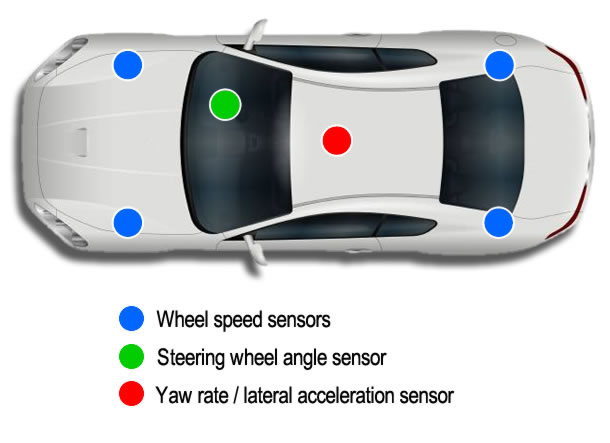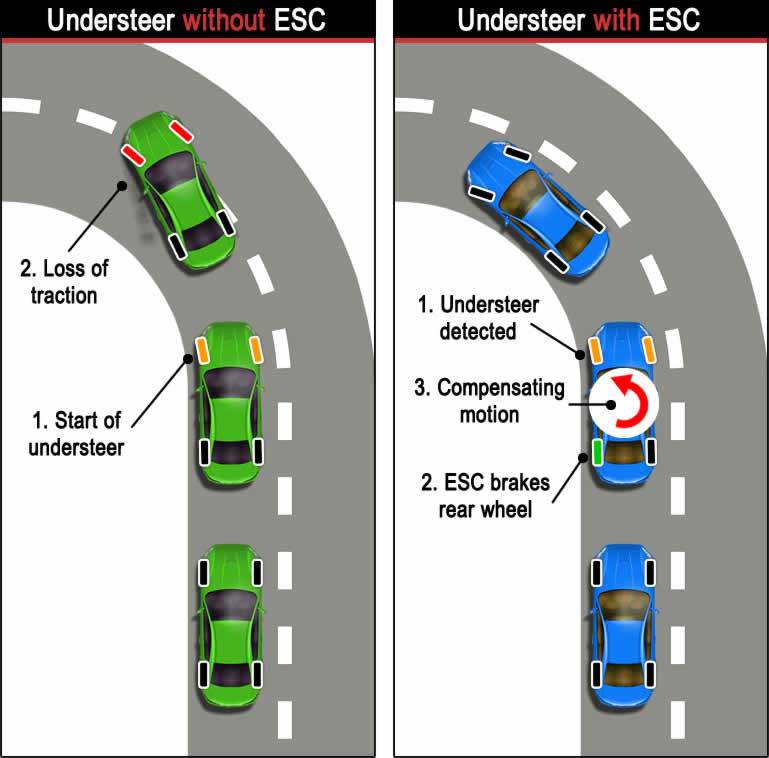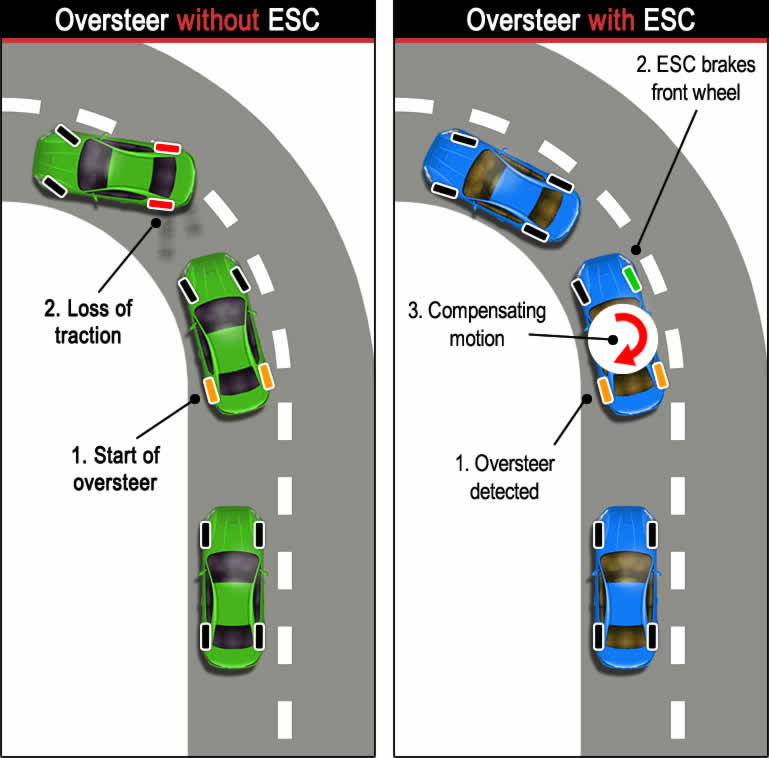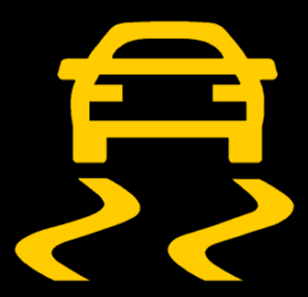Electronic Stability Control (ESC) is a safety system that was first implemented in cars back in 1995 and due to its effectiveness at reducing fatal accidents by 25 percent, ESC was made standard on all new cars from 2014.
In this tutorial, we’ll explain the basics of what Electronic Stability Control is and how it works in simple terms.
What is Electronic Stability Control in Car?
Most safety systems in cars are designed to reduce the severity of an injury following a collision. Electronic Stability Control is a car safety system that’s designed to help prevent an accident occurring in the first place.
Electronic Stability Control (ESC) is essentially an advancement of the Anti-lock Braking System (ABS). ESC uses and array of sensors around the vehicle:

The ESC system uses the following sensors to help monitor the car’s stability:
- Wheel speed sensors: One sensor located at each wheel used to track the car’s speed.
- Steering wheel angle sensor: This sensor monitors the intended steering direction of the vehicle.
- Yaw rate / lateral acceleration sensor: monitors the rotational angle of the car and centrifugal force from turning.
All of these sensors send data to the ESC unit which is capable of detecting a vehicle’s instability in milliseconds. It’s quite possible that ESC has activated and corrected the vehicle so quickly, that the driver is totally unaware.
ESC checks the data from one sensor and checks that it corresponds with the data from other sensors. For example, if the steering angle of the vehicle doesn’t match the data of the rotational angle of the vehicle, ESC is capable of braking individual wheels or cutting engine power to correct this. Making use of these sensors, ESC utilises ABS and the traction control system to:
- Correct oversteer or understeer when cornering.
- Keep the vehicle stable during sudden evasive manoeuvres.
- Prevent a loss of control with a sudden change of road conditions such as, a slippery road or standing water.
How Does Electronic Stability Control Work?
By making use of multiple sensors, Electronic Stability Control can determine within milliseconds that understeer or oversteer is occurring. The ESC system can then apply the brakes to individual wheels, or cut engine power to prevent a loss of control.
Let’s look at an example of what understeer and oversteer is and how ESC is acts to prevent a potential loss of control.
Electronic Stability Control Preventing Understeer
Understeer occurs when you turn the car’s front wheels, but rather than turning, the front wheels lose traction and the car continues going straight ahead.
Understeer may occur when making an evasive manoeuvre to avoid a collision or when cornering. The loss of traction may occur due to a slippery road surface or due to the vehicle traveling too fast. In this example, the diagram illustrates a car traveling round a left corner.

As we can see, the green car without ESC begins to understeer at the start of the corner. The front wheels lose traction and the car loses control.
The blue car with ESC detects that understeer is occurring almost immediately and applies the brake to the rear-left wheel. The compensating affect of this rotates the car anticlockwise, helping to preventing a loss of control.
Electronic Stability Control Preventing Oversteer
Oversteer occurs when the car continues to turn further than the driver intended, resulting in the rear wheels sliding.
Oversteer may occur when making an evasive manoeuvre and when the driver attempts to straighten the vehicle, the rear end slides out. Oversteer can also occur with cars that are rear-wheel-drive and where the driver applies too much power when traveling around a corner. In this example, the diagram illustrates a car traveling round a left corner.

The green car without ESC begins to oversteer and lose traction with the rear wheels at the start of the corner. As the car rounds the corner, the rear wheels lose traction and the rear of the car slides out.
The blue car with ESC immediately detects that oversteer is occurring and applies the the brake to the front-right wheel. Power to the rear wheels may also be reduced. The compensating affect of this rotates the car in a clockwise direction, helping to preventing a loss of control.
What Does it Mean When the Electronic Stability Control Light Comes On?
There are two possible reasons that cause the Electronic Stability Control light to come on:
- The ESC light is flashing which means the system is active
- The ESC light is constantly on which means there’s a system fault
If you happen to notice that the ESC light is flashing, it means that the system is actively attempting to stabilise the vehicle. If this occurs often, it may suggest that you’re frequently driving near the handling limits of your vehicle.

If the ESC light is constantly lit, it means there’s a fault with the Electronic Stability Control system. A very common reason for an ESC fault is due to one of the four wheel speed sensors. Due to the location of wheel speed sensors, they’re prone to damage and can occasionally need replacing.
If you are seeing the ESC OFF light, it means that you have either manually switched off ESC yourself or that they ESC system has been automatically disabled. ESC can often be automatically disabled by your vehicle due to another fault, particularly the engine warning light. This is to stop ESC interfering if the vehicle reduces engine power.
What are the Benefits of Electronic Stability Control?
The benefits of Electronic Stability Control are as follows:
- You are 25 percent less likely to be involved in a fatal car crash
- A car with Electronic Stability Control is 22 percent less likely to crash when compared to a car without Electronic Stability Control
- When driving on wet or icy roads, you are 38 percent less likely to lose control of your car
- A car fitted with Electronic Stability Control is 59 percent less likely to roll
Should I turn Electronic Stability Control On or Off?
There are perhaps two possible reasons why you may need to turn Electronic Stability Control off. These are:
- Being stuck in snow
- Track racing
If your car is stuck in snow, then sometimes the only option you have is to spin the tyres to generate friction to melt the snow. Having ESC on will cause the traction control system to prevent wheel spin. However, on some cars, traction control is a separate feature and can be turned off individually.
If you’re taking a car round a race track and you’re skilled enough to drive without the safety of having ESC switched on, then you’ll certainly want to turn it off. Electronic Stability Control can reduce engine power output, reduce wheel slip and prevents the car from sliding. To a skilful race driver, having ESC on will slow them down.
What Happens When You Turn Off ESC?
If you’re driving well within the limits of your vehicle, the road and weather conditions, you’ll not notice any difference at all when you turn off ESC. ESC constantly monitors your vehicle’s stability but only actively engages when instability is detected.
Are There Different Versions of Electronic Stability Control?
Electronic Stability Control has varied names and works slightly different depending on the car manufacturer, but they all achieve the same outcome; greater stability for your car. The different versions of Electronic Stability Control (ESC) include:
- BMW, Mazda and Jaguar call it Dynamic Stability Control (DSC)
- Audi, Kia, Volkswagen and Mercedes-Benz call it Electronic Stability Program (ESP)
- Toyota call it Vehicle Stability Control (VSC)
- Volvo call it Dynamic Stability and Traction Control (DSTC)
- Nissan call it Vehicle Dynamic Control (VDC)
- Honda call it Vehicle Stability Assist (VSA)
- Mitsubishi call it Active Stability Control (ASC)